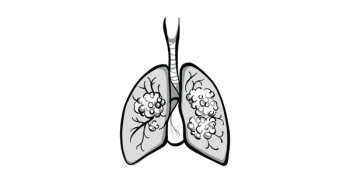
Updated Results Show Promise for IBI351 Monotherapy in KRAS G12C-Mutated Advanced NSCLC
Updated results from the phase 1 study of the bioavailable KRAS G12C inhibitor IBI351 showed that monotherapy was tolerable with promising activity in patients with advanced non–small cell lung cancer whose tumor harbored the KRAS G12C mutation.
The KRAS G12C inhibitor IBI351 (GFH925) demonstrated tolerability and antitumor activity in patients with advanced non–small cell lung cancer (NSCLC) whose tumor harbored the KRAS G12C mutation, according to results of a phase 1 dose escalation study (NCT05005234).1
Updated results in 67 patients with NSCLC receiving the inhibitor were presented at the 2023 American Association for Cancer Research Annual Meeting by Chongrui Xu, MD, on behalf of Qing Zhou, MD, and their fellow clinicians from the Guangdong Provincial People’s Hospital in Guangzhou, China. Safety results showed that 94.0% of patients experienced any grade treatment-related adverse events (TRAEs), with 31.3% of those TRAEs being grade 3 or greater.
The most frequent of the any-grade TRAEs included anemia (43.3%), pruritus (28.4%), increased alanine aminotransferase (28.4%), increased aspartate aminotransferase (28.4%), asthenia (22.4%), the presence of protein urine (22.4%), and increased blood bilirubin (20.9%). Grade 3 or higher TRAEs included anemia (7.5%), asthenia (4.5%), increased alanine aminotransferase (1.5%), presence of protein urine (1.5%), and increase of blood bilirubin (1.5%). However, no TRAEs led to the discontinuation of treatment or death.
The phase 1 study looked at the use of IBI351 in 74 patients with advanced solid tumors that harbored a KRAS G12C mutation, but 67 patients with NSCLC made up the largest cohort compared with 6 patients with colorectal cancer, and 1 patient with pancreatic cancer. According to Xu, the KRAS G12C mutation occurs in approximately 13% of patients with NSCLC globally, whereas it is observed in 2.9% to 4.3% of patients with NSCLC in China.
Eligible patients had pathologically confirmed tumors with a KRAS G12C mutation, failed or were intolerant to standard therapy, had an ECOG performance score of 0 or 1, and had not received a prior KRAS inhibitor. The dose escalation process started at 250 mg escalating to 900 mg given once a day or starting at 450 mg escalating to 750 mg given twice a day (BID). The primary end points of the study were safety, tolerability, and finding the maximum tolerated dose and recommended phase 2 dose of the KRAS inhibitor. Secondary end points included pharmacokinetics and antitumor activity as defined by RECIST v1.1.
While a maximum tolerated dose was not reached, antitumor activity was observed for patients given IBI351 at 600 mg BID. Thirty patients received the 600-mg dose, 66.7% of which had a partial response compared with 61.2% in all of the patients with NSCLC. No complete responses were observed. Thirty percent of patients in the 600-mg group had stable disease, but 31.3% in the group overall had stable disease. Two patients had progressive disease after treatment in the overall group.
The objective response (ORR) rate was similar between the 600-mg group and the overall group at 66.7% (95% CI, 47.2%-82.7%) vs 61.2% (95% CI, 48.5-72.9%), respectively. The confirmed ORR for the 600-mg dose was 53.3% (95% CI, 34.3%-71.7%) and the disease control rate was 96.7% (95% CI, 82.8%-99.9%). These results led to the 600 mg BID dose to be the investigators recommended phase 2 dose.
Median duration of response (DOR) was not reached in this study, but the 6-month DOR rate was 75.4% (95% CI, 39.8-91.7%) in the 600-mg group. Progression-free survival (PFS) for this group had a median follow up of 8.1 months and there was a median PFS of 8.2 months (95% CI, 5.5–not completed). There were 14 PFS events with a 6-month PFS rate of 58.9% (95% CI, 39.0%-74.3%) and a 9-month PFS rate of 47.3% (95% CI, 26.1-65.8%). However, according to Xu, these PFS data are still immature.
Patients on the trial had a median age of 65 years (range, 42-76 years), 98.5% had adenocarcinoma pathological type, and 38.8% had brain metastases. Most patients had at least 1 prior line of systemic therapy at 53.7% and 44.8% who had 2 or more lines of therapy. This was reflected in the patient case Xu shared at the conference of a 70-year-old former smoker with KRAS G12C-mutated NSCLC with brain, left node, and bone metastases, and a treatment history of several therapy combinations.
Once the patient was given IBI351, a partial response was achieved after 2 cycles of treatment and a persistent response of the brain metastases was also observed. The patient experienced grade 3 increase of gamma-glutamyl transferase that decreased over time and grade 2 rash, pruritus, and an increase of serum amylase. This patient remained on the study at the time of the presentation with partial response.
Reference:
1. Zhou Q, Xu C, Yang N, et al. Phase 1 study of IBI351 (GFH925) monotherapy in patients with advanced solid tumors: updated results. Presented at: 2023 AACR Annual Meeting; April 14-19, 2023; Orlando, FL. Abstract CT030.








































